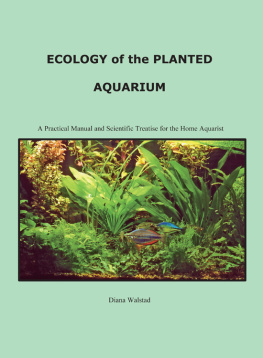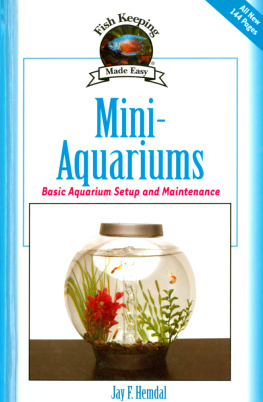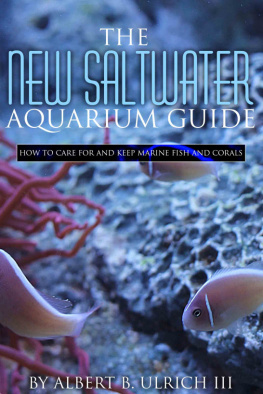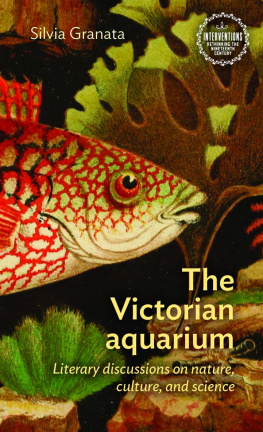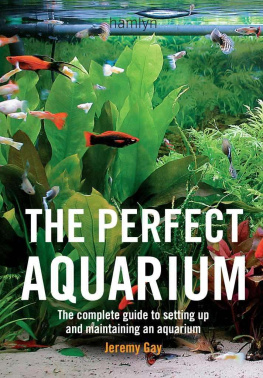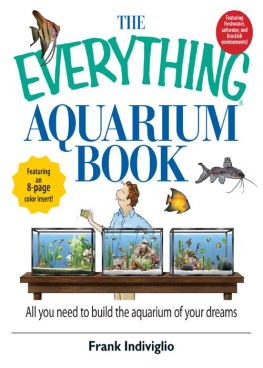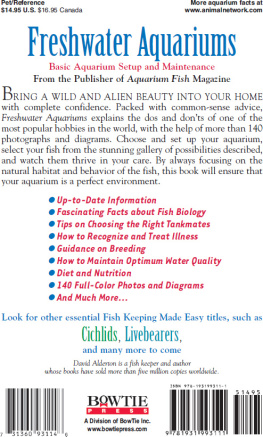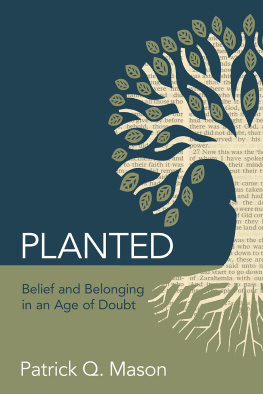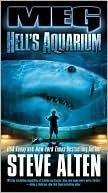
COLOR PLATES
Color Plate 1. Blue Guppies in a 29 gal Tank. I can catch guppies and their babies easily in this 29 gal planted tank where one end has potted plants on bricks (see Q&A on ). Blue guppies like these are hard to find, so I bred them myself. I crossed a store-bought male of brilliant iridescent blue coloring with a healthy female show guppy with a large delta tail. Like many of the imported guppies offered in stores, the male did not last long. I kept him alive just long enough (using a bare quarantine tank dosed with antibiotics) to impregnate the female guppy. Afterwards, I kept the female separated from all other males; her second batch of babies was from the desired mating. By selectively breeding offspring from the planned mating, I eventually got the fancy blue guppies depicted in the photo.
Color Plate 2. Bluespotted Sunfish in a 45 gal Tank. The Bluespotted Sunfish (Enneacanthus gloriosus) is a small, beautiful native fish found in ponds and lakes from New York to Florida. They are hardy, unaggressive, and get no bigger than 2-3 inches. Ideally, they should get live food. They will not eat flake food. However, I have maintained mine for several years feeding them mainly freeze dried bloodworms and small cichlid pellets. They will go wild for fresh earthworms.
Color Plate 3. Juvenile Cichlids in a 20 gal Grow-out Tank. For many years, I raised and sold Tanganyikan cichlids. They tend to be smaller and less aggressive than the Lake Malawi cichlids. I obtained juvenile fish from cichlid breeders listed with the American Cichlid Association. I consider the cost of the fish (about $5-$25 each) cheap considering the fact that the fish I obtained were consistently healthy (not one succumbed to disease) and of high quality. At times, I kept over a hundred juveniles in this tank with a small hang-on-the back filter. Intense lighting and rapid emergent plant growth from the depicted Water Sprite (Ceratopteris thalictroides) kept the fish healthy with minimal maintenance.
Color Plate 4. Small Tanks for Pet Shrimp. I set up these two 2 gal tanks in 2009 using the Dry Start Method. That is, I grew the plants emersed for 10-11 weeks before adding water and the shrimp. As of 2012, the tanks and shrimp continue to do well. The Dry Start Method gives delicate plants a better chance to survive tank setup, which is always tricky. I describe the setup in my article Small Planted Tanks for Pet Shrimp.
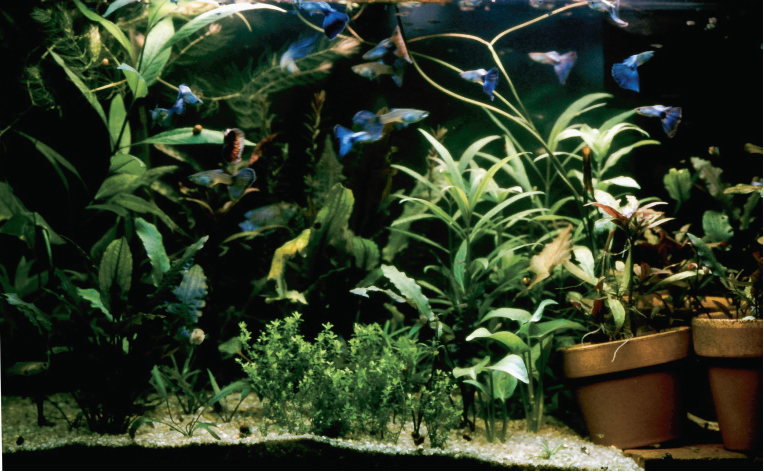
Color Plate 1. Fancy Blue Guppies in a 29 gal Tank.
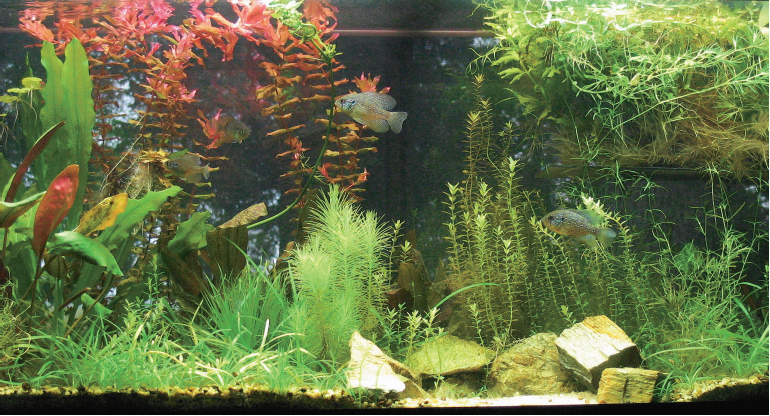
Color Plate 2. Bluespotted Sunfish in a 45 gal Tank.
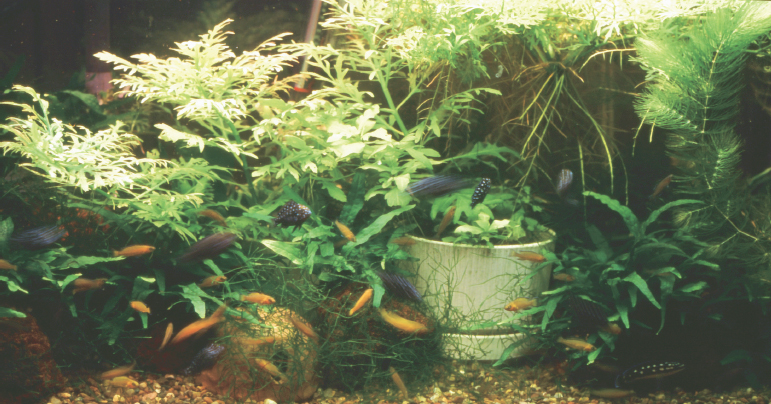
Color Plate 3. Juvenile Cichlids in a 29 gal Grow-out Tank.
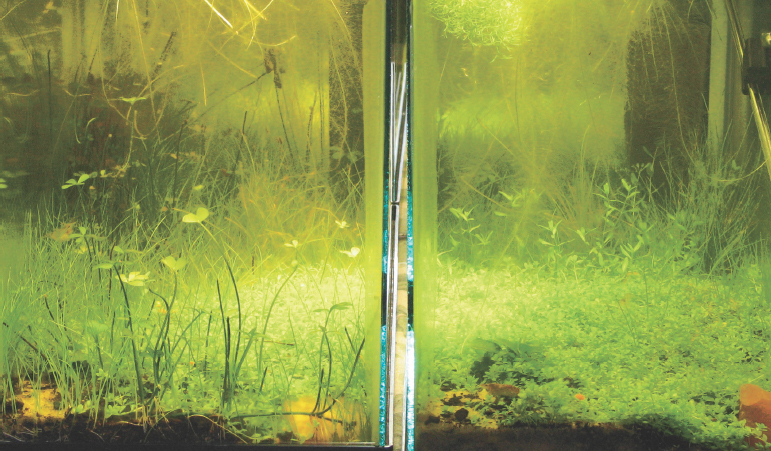
Color Plate 4. Small Tanks for Pet Shrimp.
Ecology of the Planted Aquarium
A Practical Manual and Scientific Treatise for the Home Aquarist
by
Diana L. Walstad
Echinodorus Publishing, Chapel Hill, North Carolina (U.S.A.)
Ecology of the Planted Aquarium
A Practical Manual and Scientific Treatise for the Home Aquarist
by Diana L. Walstad
Published by:
Echinodorus Publishing
2303 Mt Sinai Rd.
Chapel Hill, NC 27514
All rights reserved. Except for a brief quotation in critical reviews, all reproductions or use of this work is forbidden without written permission from the author or publisher.
Copyright 1999, 2003, 2012 by Echinodorus Publishing
Third Edition
Library of Congress Catalog Number 99-72828
Ecology of Aquarium Plants: a practical manual and scientific treatise for the home aquarist / by Diana L. Walstad
Includes table of contents, color plates, bibliographical references, and subject index ISBN 978-0-9673773-6-0
1. Aquariums (about)
2. Aquariums- handbooks, manuals, etc
3. Aquarium plants
4. Aquatic plants
5. Ecology (in aquariums)
Printed in USA (BookMasters Inc of Ashland OH)
This book is dedicated to my parents Paul and Marjorie Walstad
Acknowledgements
Below is a list of scientists and professors who have helped me. They have taken the time from their busy schedules to review and comment on parts of the manuscript. Their ideas, comments, and critique have molded and reshaped many of my theories and helped keep the book on track.
Dave Huebert, Department of Botany, University of Manitoba (Canada)
Elisabeth Gross, Limnology Institute, University Konstanz (Germany)
Laura Serrano, Department of Ecology, University of Sevilla (Spain)
Giovanni Aliotta, Dipartimento di Biologia Vegetale, Universita Degli Studi di Napoli Federico II (Naples, Italy)
Wolfram Ullrich, Institute of Botany, Technische Hochschule Darmstadt (Germany)
Dan Weber, NIEHS Marine and Freshwater Biomedical Core Center, University of Wisconsin (Milwaukee)
David Spencer, Plant Biology Section, Aquatic Weed Control Research Laboratory, University of California (Davis)
George Bowes, Department of Botany, University of Florida (Gainesville)
Anthony Paradiso, Cystic Fibrosis Center, University of North Carolina (Chapel Hill)
Claude E. Boyd, Department of Fisheries and Allied Aquacultures, Auburn University (AL)
During my 5-year tenure as Technical Advisor for the AGA (Aquatic Gardeners Association), I accumulated many Questions and Answers (Q&As). I have included many of those Q&As in the book and would like to thank AGA members for their permission to use them. I would also like to thank Neil Frank, previous editor of the AGA, who twice reviewed manuscript drafts of the book. His insightful comments helped.
To Robert G. Wetzel, Biology Professor and a leading authority on freshwater ecology, I owe special thanks. First, his comprehensive reference work (Limnology) prompted my initial search of the scientific literature on aquatic ecology. Second, his enthusiastic review of the first draft of Ecology of the Planted Aquarium convinced me that my book was worth the trouble.
The Second Edition has been updated only slightly from the First Edition. The main difference is that it includes the color plates.
TABLE OF CONTENTS
.
Ecology of the Planted Aquarium should appeal to hobbyists who wish to set up a successful planted aquarium plus understand more about its ecology.
Most aquarium plant books simply list/describe plant species or show how to set up a planted aquarium. This book is unique. For it explains the underlying mechanisms of the aquarium ecosystem how plants affect the ecosystem and how the ecosystem affects the plants. It shows that plants are not just decorative but can also be quite useful in keeping fish healthy and reducing aquarium maintenance.
In addition, my book presents extensive scientific information that hobbyists have never seen. This information often contradicts prevailing ideas in the aquarium hobby ideas that are often based on antiquated books and hobbyist observations rather than experimental data.

